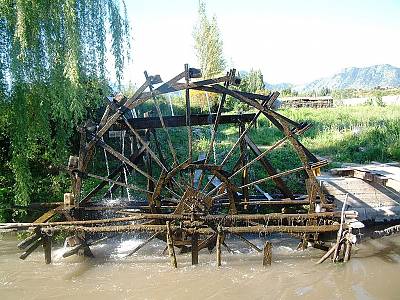- Chile


Larmahue Water Wheel Irrigation System in Chile

© “Rueda Larmahue” by Warko is licensed under CC BY-SA 2.5
1. ICH domains
Knowledge and practices concerning nature and the universe, traditional craftsmanship
2. Short description
Water wheels for crop irrigation are a known approach in rural areas with water shortages. The Larmahue community in the Cachapoal valley of Chile has developed a unique water management and distribution system that for more than 150 years has maintained crops and ensured food production. Water is distributed through the water wheels and canals to the highest and driest land in the region. Distribution begins in September with the planting period and runs until May, when the canals are closed for cleaning, until the next period of water distribution.
In 1998, 17 of the 40 wheels were named National Monuments of Chile. During the same year, the last remaining water wheel builder, Arturo Lucero, was named a Living Human Treasure by the Culture and Arts Council of Chile (current Ministry of Culture, Arts and Heritage of the Government of Chile). Unfortunately, an earthquake struck the region in 2010, affecting the system. During this period, villagers created a shift-based system of use and assistance which saw the temporary loan (for a few hours) of water wheels that had survived the earthquake, aimed at both overcoming difficult dryland conditions and ensuring there was no shortage of irrigation in the fields.
Further information:
The following links provide additional images and information on the Lamarhue water wheels (in Spanish):
https://www.youtube.com/watch?v=PiUFu9J0Vr0
https://www.youtube.com/watch?v=lI8RYXOLQmA
https://www.youtube.com/watch?v=TbI6JsamcIc
Links to academic studies on this element (in Spanish):
http://www.scielo.cl/scielo.php?script=sci_arttext&pid=S0718-83582014000300007
http://www.tesis.uchile.cl/tesis/uchile/2011/aq-soto_c/html/index-frames.html
3. Link with sustainable development
The water wheels are a material manifestation of culture closely linked to the Lamarhue community’s rural way of life. The immaterial implications of the water wheels are expressed in the unique irrigation approach, by which the local agricultural system is passed down from one generation to the next. Moreover, the water wheels are a significant reference for local identity. More broadly, the water wheels represent an important contribution to SDG 6, focused on ensuring access to water to all and SDG 2 in helping achieve food security through sustainable agriculture.
4. Questions for reflection
The long-practiced construction and maintenance of the water wheels remains the exclusive domain of some artisans. In addition, transmission of construction techniques has been entirely practical and oral, representing a challenge for the safeguarding of this knowledge. Furthermore, their fragility in the face of natural and human actions (garbage in the canal and floods), neglect and lack of economic resources for their maintenance and conservation led, in 2002, to the World Monuments Watch listing the water wheels as a cultural heritage site in danger. What else could be done to ensure the continued transmission and viability of the Larmahue water wheel irrigation system?